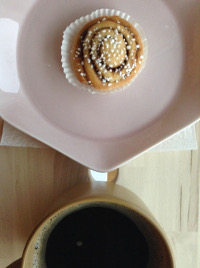cafe pascal
22 Feb 2020
Even though third time’s the charm, I almost didn’t make into Cafe Pascal this time either - the third attempt. All of this, because at some point during my years in London, I had developed an anxiety about entering busy coffee shops and frantically searching for a place to park my inelegant body, while the elegant, well-dressed people at the tables have me pitiful glances in between taking bites of their avocado toasts and ardent concentration on ignoring the waves of disturbance in the ambience. Of course, a large part of this reality existed solely in my head, but it didn’t make the anxiety resulting from these images any less real.
So on my first two attempts I’d let anxiety win. I’d walked past the cafe, giving, casual, nonchalant glances at the glass windows to see how crowded it was. It was crowded, there was a queue, just like the past two times. I made a loop on the street, pretending I was lost instead of indecisive, checking my watch, even though I had no interest in the time, but pretending, to anyone watching, that I was waiting for a friend on this nondescript street branching off of Odenplan in Stockholm. Then finally, I opened the door and went inside.
It was warm inside, the air peppered with a lively buzz of conversation, with cosmopolitan mixes of accented English, and the gentle tinkle of china and silverware as tea and coffee cups were lowered and then picked up again by people enjoying a Saturday morning coffee.
The interior style was a bit of everything and not exactly anything. Rustic, but not full-blown countryhouse-en-Provence rustic, scandichic, but not overly clinical and airport-asceptic, hygge, but not too many knitted sweaters and fluffyy woollen socks, shabbychic yet also somehow neat and new. It wasn’t committed to any extreme. It was lagom, just right, as the Swedish tend to say.
I waited for my turn and stumbled over the Swedish words necessary to order an oat milk latte (yes, I am one of those people whose Starbucks orders contain more coffee dressing than actual caffeine bearing substance and you are free to heckle me for it) and a semla - a seasonal Mardi Gras pastry (though it’s sold starting January through to Easter), sliced into two pieces and filled with almost paste (mandelmassa) and whipped cream.
No one wore plaid or asked me whether I’d prefer one arcane roast over another (even though looking at the drinks menu, coffee connoisseurs would love it here) while rolling their eyes at my blank stare and pleibian tastes in coffee (I once made the mistake of saying “Whichever” to a question like that at Alchemy in London and received a very disapproving eyeroll, but that’s a story for another time).
One of the baristas had a manbun (not uncommon in the streets of Stockholm) and looked like an Australian surfer-dude who could at any point surprise you by interspersing a g’day mate in between his Swedish.
I sat at one of the large communal tables opposite the coffee counter - the perfect vantage point for sampling the atmosphere. People walked by in large, puffy down coats and overly large woollen cardigans. The style here had a definite air of hygge sprezzatura - a careful carelessness meets shabbychic and your grandma’s closet. Oversized knitted sweaters were paired with skintight yoga pants and vintage Chanelesque clutches. But beneath all of this nordic bohemianism ran a whiff of wealth, carefully channeled into an inconspicuous style.
One might call this style a Stockholm version of the bobo (short for bohemian bourgeoisie) parisienne. This person, often female, fluttered in and out of the pages of Parisian and wannabe-Parisian fashion magazines, talked about Sartre and Bauhaus on lifestyle YouTube channels while showing us her carefully careless 20-step French skincare routine and effortlessly elegant 2 million dollar 16th arrodissement apartment. The Swedish version would probably be called the sofo stockholmare. Sofo, to imitate the iconic chic names of places like SoHo and NoLita, denoted a particular, gentrifying area in the south of Stockholm, where teslas and hipsters mingled with art studios and design agencies.
From my community table, I observed elegant, lithe women with perfectly trimmed bobs and well fitting turtlenecks engagaed in lively conversations with friends and partners and I imagined that most of their life was set against a backdrop of elegant places like these that served avocado toast and V60 while they and those arround them discussed promotions, examined enagament rings and planned stylish, expensive vacations.
I immediately felt out of place. My wardrobe was (still is) mostly what I’d had in London. I’d spent a good chunk of my career working in places that did not have a relaxed, careless attitude about dressing. As a result, neither did my wardrobe. Whatever I was wearing looked, here, like I was trying too hard, like I’d dressed for a job interview to come to a cafe and write, like I didn’t belong.
To add insult to injury, the easy availability of pastries hadn’t helped my billowing wasteline much either and some ugly spectres from my previous battles with my body started to rear their ugly heads.
Just as these thoughts started to swirl in my mind, my neck protested against the cramped writing conditions at the table and I packed up and left for the commuter train back to the suburbs.